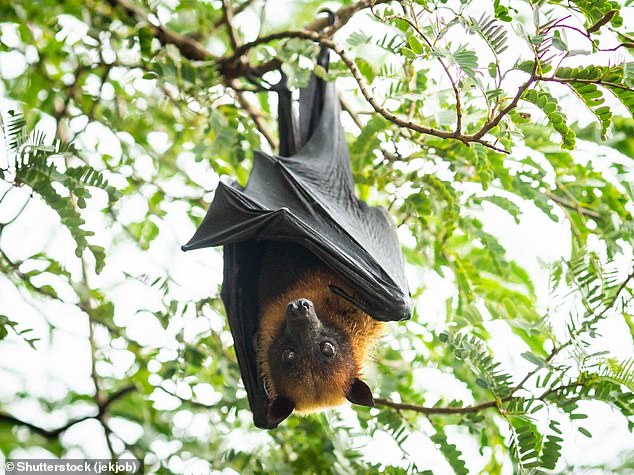More viruses will jump from animals to humans in future because of global travel and a growing population, warns top scientist behind Oxford University’s coronavirus vaccine
- Professor Sarah Gilbert warned of more outbreaks of zootonic diseases in future
- Farming and deforestation brings animals closer to each other and to humans
- International travel and growing populations make it easier for viruses to thrive
More diseases with pandemic potential are likely to jump from animals to humans in the near future because of modern lifestyles, a top professor warned today.
Sarah Gilbert, the brains behind Oxford University’s Covid-19 vaccine, said rising world travel and growing populations are driving up the risk of outbreaks of zoonotic infections.
Animal-borne diseases have become more common in recent years because of intense farming for meat and deforestation, which both put animals in closer proximity with each other and to humans.
Professor Gilbert said the current pandemic highlighted how international travel exacerbates the spread of these viruses and bigger populations make them harder to eradicate.
Covid-19’s exact origin is currently unknown, but the consensus is that it originated in bats before jumping to another animal which then passed it to people.
Professor Gilbert, a vaccinologist at Oxford’s Jenner Institute, told The Independent: ‘Because of the way things have been going in the world, it’s more likely we’ll have zoonotic infections causing outbreaks in the future.
‘Greater population density, greater travel, deforestation – all of these things make it more likely that these outbreaks will happen and then something will spread.’

Sarah Gilbert, the brains behind Oxford University’s Covid vaccine, said rising world travel and growing populations drove up the risk of outbreaks of zoonotic infections

Covid-19’s exact origin is currently unknown, but the consensus is that it originated in bats before jumping to another animal which then passed it to people (stock image)
Covid-19 has proven to be the most deadly and contagious zoonotic disease, having claimed the lives of 850,000 people globally and infected more than 25million.
But other deadly examples include Ebola, which originated in monkeys, MERS, which emerged in camels, the mosquito-borne West Nile Virus and rabies, mainly found in dogs. Every year two million people — mostly in poor countries — die of zoonotic disease.
It comes after a United Nations report in July warned the number of outbreaks of such infections will continue to increase unless conservation work is done to protect wildlife.
A ‘zoonotic disease’ is one that is able to be transmitted from a vertebrate animal — such as a mammal, bird, reptile or fish — to a human.
Professor Delia Randolph, a veterinary epidemiologist and lead author of the UN report, described a ‘very clear trend’ since the 1930s that showed that 75 per cent of emerging human diseases stemmed from wildlife.
Destruction of animals’ habitats forces them into closer contact with humans, raising the risk of disease transmission.
Climate change can contribute to this by making extreme weather events like flooding more common, driving animals out of their homes.
In Madagascar, for example, the bubonic plague is spread by rodents fleeing wildfires, which are becoming more common as the Earth heats up.
Human activity also often breaks down the natural barriers which protect humans from disease pathogens, according to the UNEP.
A major transmission route between the environment and humans is through the hunting and eating of wild, exotic animals.
Illegal wildlife trade can see a range of live animals, including bats, come into close proximity with people in markets.
Snakes, beavers, porcupines and baby crocodiles were among the species for sale at the Huanan Seafood Wholesale Market in Wuhan, which was originally believed to have been the epicentre of the Covid crisis.
But the jury is still out on whether the disease actually originated there after international scientists investigating the cause of the outbreak found no evidence of disease at the maligned market.
There is now growing speculation that the virus may have accidentally spilled out of a biochemical laboratory in Wuhan city.
The theory has been fuelled in part by US President Donald Trump, who said he had been handed evidence by the US intelligence community showing this was the case.
Professor Gilbert announced this week that data for her team’s Covid-19 vaccine – called AZD1222 – would be presented to regulators soon.
The Oxford project is awaiting results of phase three trials of its vaccine and, if a high level of efficacy is proven, the team hopes it could be available be the end of the year.
Oxford’s pharmaceutical partner in the project, AstraZeneca, has committed to producing two billion doses by next summer.
The vaccine is being trialled in tens of thousands of volunteers in the UK, South Africa, Brazil and the US.
Other vaccines in development around the world have entered into the same stage, and Professor Gilbert said there was a ‘very good chance’ some would prove effective.
‘We’ve seen good levels of neutralising antibodies, we’re seeing strong T cell responses from some of them. If this works, other vaccines will also work. We expect there to be multiple vaccines,’ she told the paper.
